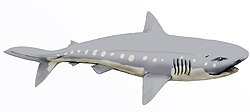Paleobiota
Most fish are documented in Diedrich (2012) and a species list from Amalfitano et al (2020). [7] [9]
Bony fish
| Genus | Species | Location | Material | Notes | Images |
|---|---|---|---|---|---|
| Apateodus | A. striatus | An ichthyotringid aulopiform. |  | ||
| Armigatus | A. brevissimus | An ellimmichthyiform clupeomorph. |  | ||
| Anomoeodus | A. angustus | A pycnodont. |  | ||
| A. muensteri | |||||
| Aulolepis | A. typus | A ctenothrissiform. |  | ||
| Apsopelix | A. anglicus | A crossognathid crossognathiform. |  | ||
| Bananogmius | B. ornatus | A plethodid tselfatiiform. Preserved with Clupavus in the stomach. |  | ||
| Belonostomus | B. cinctus | An aspidorhynchid. | |||
| Cimolichthys | C. levesiensis | A cimolichthyid aulopiform. |  | ||
| Clupavus | C. maroccanus | A basal ostariophysian. The most common fish of the formation. | |||
| Cylindracanthus | C. cf. minor | Rostral fragment | A fish of uncertain affinities. |  | |
| Dercetis (=Leptotrachelus) | D. sp. | A dercetid aulopiform. |  | ||
| ? Dixonanogmius | D. sp. [10] | A plethodid. | |||
| Elopopsis | E. microdon | A pachyrhizodontid crossognathiform. | |||
| Enchodus | E. lewesiensis | An enchodontid aulopiform. |  | ||
| E. venator | |||||
| Hoplopteryx | H. lewesiensis | A trachichthyiform. |  | ||
| Ichthyodectes | I. sp. | An ichthyodectid. |  | ||
| Ichthyotringa | I. africana | An ichthyotringid aulopiform. |  | ||
| Njoerdichthys | N. dyckerhoffi [11] | Galgenknapp Quarry, Hohne Quarry | A pycnodont. | ||
| Osmeroides | O. lewesiensis | An osmeroidid elopiform. |  | ||
| Pachyrhizodus | P.subulidens | A pachyrhizodontid crossognathiform. |  | ||
| P. sp. | |||||
| Paranursallia | P. gutturosa | A pycnodont. |  | ||
| Protosphyraena | P. sp. | A billfish-like pachycormid. |  | ||
| " Pycnodus " | "P." scrobiculatus | A pycnodont. | |||
| Rhamphoichthys | R. taxidiotis [10] | DIMAC Quarry | A billfish-like plethodid. |  | |
| Rharbichthys | R. ferox | An aulopiform. | |||
| Rhynchodercetis | R. sp. | A dercetid aulopiform. | | ||
| Protostomias | P. maroccanus | A dragonfish-like teleost. | |||
| Tselfatia | T. formosa | A plethodid. |  | ||
| Xiphactinus | X. sp. | An ichthyodectid. |  |
Chondrichthyans
| Genus | Species | Location | Material | Notes | Images |
|---|---|---|---|---|---|
| Cantioscyllium | C. decipiens | A nurse shark. | |||
| Carcharias | C. sp. | A sand shark. |  | ||
| Chiloscyllium | C. greenei | A bamboo shark. |  | ||
| Cretalamna | C. appendiculata | An otodontid shark. |  | ||
| Cretascyliorhinus | C. aff. destombesi | A scyliorhinid shark. | |||
| Cretodus | C. semiplicatus | A pseudoscapanorhynchid shark. |  | ||
| Cretoxyrhina | C. denticulata | A cretoxyrhinid shark. |  | ||
| C. mantelli | |||||
| Diprosopovenator | D. hilperti [5] | Partial body fossils | A pseudoscyliorhinid shark (formerly Paraorthacodus sp.) | ||
| ? Eostriatolamia | ?E. subulata | A sand shark. | |||
| Heterodontus | H. caniculatus | A bullhead shark. |  | ||
| H. polydictyos | |||||
| Paranomotodon | P. angustidens | A thresher shark. | |||
| Protolamna | P. acuta | A pseudoscapanorhynchid shark. |  | ||
| P. sokolovi | |||||
| Pseudoscyliorhinus | P. schwarzhansi | A pseudoscyliorhinid shark | |||
| Posadaia | P. nolfi | A sand shark. | |||
| Pseudospinax | P. pusillus | A bamboo shark. | |||
| Ptychodus | P. decurrens | Articulated specimen, teeth | A ptychodontid shark. |  | |
| P. mammilaris | |||||
| Polyacrodus | P. polyptychus | A hybodontid shark. |  | ||
| Scapanorhynchus | S. raphiodon | A goblin shark. |  | ||
| Squalicorax | S. falcatus | A crow shark. |  | ||
| Squatina (Cretascyllium) | S. cranei | An angelshark. |  | ||
| Squatirhina | S. westfalica | A ray of uncertain affinities. | |||
| Turoniabatis | T. ornata | A ray of uncertain affinities. |
Reptiles
| Genus | Species | Location | Material | Notes | Images |
|---|---|---|---|---|---|
| Coniasaurus | C. crassidens [12] | DIMAC quarry | Dentary, teeth | A dolichosaurid squamate |  |
| Dolichosaurus | D. longicollis [12] | DIMAC quarry | Dorsal vertebra | A dolichosaurid squamate |  |
| Mosasauroidea indet. [12] | DIMAC quarry | Articulated tail | The oldest articulated mosasaur remains from Europe. |